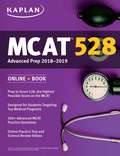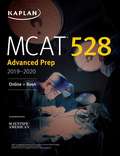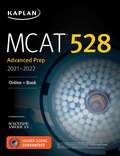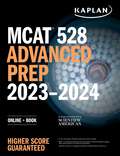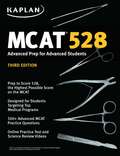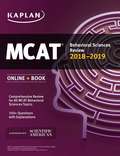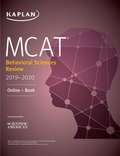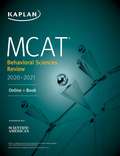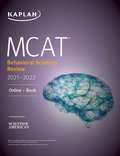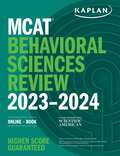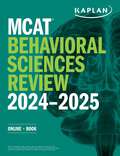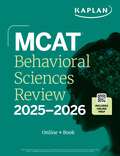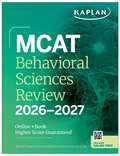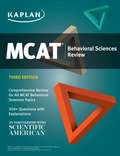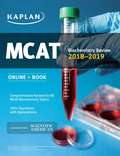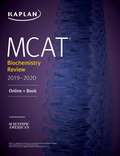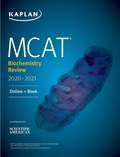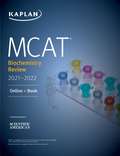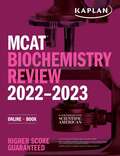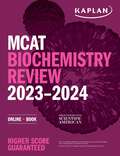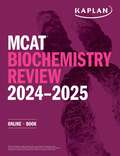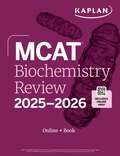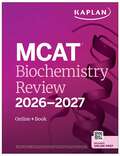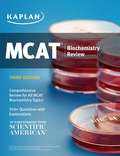- Table View
- List View
MCAT 528 Advanced Prep 2018-2019: Online + Book
by Kaplan Test PrepKaplan's MCAT 528 Advanced Prep 2018-2019 features thorough subject review, more questions than any competitor, and the highest-yield questions available – all authored by the experts behind the MCAT prep course that has helped more people get into medical school than all other major courses combined.Prepping for the MCAT is a true challenge. Kaplan can be your partner along the way – offering guidance on where to focus your efforts, how to organize your review, and targeted focus on the most-tested concepts. This edition features commentary and instruction from Kaplan's MCAT experts and has been updated to match the AAMC's guidelines precisely—no more worrying if your MCAT review is comprehensive!The Most PracticeMore than 500 questions in the book and access to even more online – more practice than any other advanced MCAT book on the market.The Best PracticeComprehensive subject review is written by top-rated, award-winning Kaplan instructors.All material is vetted by editors with advanced science degrees and by a medical doctor.Online resources help you master the computer-based format you'll see on Test Day.Expert GuidanceStar-Ratings throughout the book indicate how important each topic will be to your score on the real exam—informed by Kaplan's decades of MCAT experience and facts straight from the testmaker.We know the test: The Kaplan MCAT team has spent years studying every MCAT-related document available.Kaplan's expert psychometricians ensure our practice questions and study materials are true to the test.
MCAT 528 Advanced Prep 2019-2020: Online + Book (Kaplan Test Prep)
by Kaplan Test PrepKaplan's MCAT 528 Advanced Prep 2019-2020 features thorough subject review, more questions than any competitor, and the highest-yield questions available – all authored by the experts behind the MCAT prep course that has helped more people get into medical school than all other major courses combined.Prepping for the MCAT is a true challenge. Kaplan can be your partner along the way – offering guidance on where to focus your efforts, how to organize your review, and targeted focus on the most-tested concepts. This edition features commentary and instruction from Kaplan's MCAT experts and has been updated to match the AAMC's guidelines precisely—no more worrying if your MCAT review is comprehensive!The Most PracticeMore than 500 questions in the book and access to even more online – more practice than any other advanced MCAT book on the market.The Best PracticeComprehensive subject review is written by top-rated, award-winning Kaplan instructors.All material is vetted by editors with advanced science degrees and by a medical doctor.Online resources, including a full-length practice test, help you master the computer-based format you'll see on Test Day.Expert GuidanceStar-Ratings throughout the book indicate how important each topic will be to your score on the real exam—informed by Kaplan's decades of MCAT experience and facts straight from the testmaker.We know the test: The Kaplan MCAT team has spent years studying every MCAT-related document available.Kaplan's expert psychometricians ensure our practice questions and study materials are true to the test.
MCAT 528 Advanced Prep 2021â€"2022: Online + Book (Kaplan Test Prep)
by Kaplan Test PrepKaplan's MCAT 528 Advanced Prep 2021–2022 features thorough subject review, more questions than any competitor, and the highest-yield questions available—all authored by the experts behind the MCAT prep course that has helped more people get into medical school than all other major courses combined.Prepping for the MCAT is a true challenge. Kaplan can be your partner along the way—offering guidance on where to focus your efforts, how to organize your review, and targeted focus on the most-tested concepts. This edition features commentary and instruction from Kaplan's MCAT experts and has been updated to match the AAMC's guidelines precisely—no more worrying if your MCAT review is comprehensive!The Most PracticeMore than 500 questions in the book and access to even more online—more practice than any other advanced MCAT book on the market.The Best PracticeComprehensive subject review is written by top-rated, award-winning Kaplan instructors.All material is vetted by editors with advanced science degrees and by a medical doctor.Online resources, including a full-length practice test, help you master the computer-based format you'll see on Test Day.Expert GuidanceStar Ratings throughout the book indicate how important each topic will be to your score on the real exam—informed by Kaplan's decades of MCAT experience and facts straight from the testmaker.We know the test: The Kaplan MCAT team has spent years studying every MCAT-related document available.Kaplan's expert psychometricians ensure our practice questions and study materials are true to the test.
MCAT 528 Advanced Prep 2023-2024: Online + Book (Kaplan Test Prep)
by Kaplan Test PrepKaplan's MCAT 528 Advanced Prep 2023–2024 features thorough subject review, more questions than any competitor, and the highest-yield questions available—all authored by the experts behind the MCAT prep course that has helped more people get into medical school than all other major courses combined.Prepping for the MCAT is a true challenge. Kaplan can be your partner along the way—offering guidance on where to focus your efforts, how to organize your review, and targeted focus on the most-tested concepts. This edition features commentary and instruction from Kaplan's MCAT experts and has been updated to match the AAMC's guidelines precisely—no more worrying if your MCAT review is comprehensive!The Most PracticeMore than 500 questions in the book and online and access to even more online—more practice than any other advanced MCAT book on the market.The Best PracticeComprehensive subject review is written by top-rated, award-winning Kaplan instructors.All material is vetted by editors with advanced science degrees and by a medical doctor.Online resources, including a full-length practice test, help you master the computer-based format you'll see on Test Day.Expert GuidanceStar Ratings throughout the book indicate how important each topic will be to your score on the real exam—informed by Kaplan's decades of MCAT experience and facts straight from the testmaker.We know the test: The Kaplan MCAT team has spent years studying every MCAT-related document available.Kaplan's expert psychometricians ensure our practice questions and study materials are true to the test.
MCAT 528: Advanced Prep for Advanced Students
by KaplanMore people get into medical school with a Kaplan MCAT course than all major courses combined. Now the same results are available with Kaplan's MCAT 528. This book features thorough subject review, more questions than any competitor, and the highest-yield questions available. The commentary and instruction come directly from Kaplan MCAT experts and include targeted focus on the most-tested concepts.MCAT 528 offers:UNPARALLELED MCAT KNOWLEDGE: The Kaplan MCAT team has spent years studying every MCAT-related document available. In conjunction with our expert psychometricians, the Kaplan team is able to ensure the accuracy and realism of our practice materials.THOROUGH SUBJECT REVIEW: Written by top-rated, award-winning Kaplan instructors, all material has been vetted by editors with advanced science degrees and by a medical doctor.EXPANDED CONTENT THROUGHOUT: As the MCAT has continued to develop, this book has been updated continuously to match the AAMC's guidelines precisely--no more worrying if your prep is comprehensive!"STAR RATINGS" FOR EVERY SUBJECT: New for the 3rd Edition of MCAT 528, every topic is assigned a "star rating"--informed by Kaplan's decades of MCAT experience and facts straight from the testmaker--of how important it will be to your score on the real exam.MORE PRACTICE THAN THE COMPETITION: With 500+ questions throughout the book and access to a full-length practice test online, MCAT 528 has more practice than any other advanced MCAT book on the market.ONLINE COMPANION: One practice test and additional online resources help augment content studying. The MCAT is a computer-based test, so practicing in the same format as Test Day is key.KAPLAN'S MCAT REPUTATION: Kaplan is a leader in the MCAT prep market, and twice as many doctors prepared for the MCAT with Kaplan than with any other course.*UTILITY:MCAT 528 can be used alone or with the other companion books in Kaplan's MCAT Review series. * Doctors refers to US MDs who were licensed between 2001-2010 and used a fee-based course to prepare for the MCAT. The AlphaDetail, Inc. online study for Kaplan was conducted between Nov. 10 - Dec. 9, 2010 among 763 US licensed MDs, of whom 462 took the MCAT and used a fee-based course to prepare for it.
MCAT Behavioral Sciences Review 2018-2019: Online + Book
by Kaplan Test PrepKaplan's MCAT Behavioral Sciences Review offers an expert study plan, detailed subject review, and hundreds of online and in-book practice questions – all authored by the experts behind the MCAT prep course that has helped more people get into medical school than all other major courses combined.Prepping for the MCAT is a true challenge. Kaplan can be your partner along the way – offering guidance on where to focus your efforts and how to organize your review. This book has been updated to match the AAMC's guidelines precisely—no more worrying if your MCAT review is comprehensive!The Most PracticeMore than 350 questions in the book and access to even more online – more practice than any other MCAT behavioral sciences book on the market.The Best PracticeComprehensive behavioral sciences subject review is written by top-rated, award-winning Kaplan instructors.Full-color, 3-D illustrations from Scientific American, charts, graphs and diagrams help turn even the most complex science into easy-to-visualize concepts.All material is vetted by editors with advanced science degrees and by a medical doctor.Online resources help you practice in the same computer-based format you'll see on Test Day.Expert GuidanceHigh-yield badges throughout the book identify the top 100 topics most-tested by the AAMC.We know the test: The Kaplan MCAT team has spent years studying every MCAT-related document available.Kaplan's expert psychometricians ensure our practice questions and study materials are true to the test.
MCAT Behavioral Sciences Review 2019-2020: Online + Book (Kaplan Test Prep)
by Kaplan Test PrepA Simon & Schuster eBook. Simon & Schuster has a great book for every reader.
MCAT Behavioral Sciences Review 2020-2021: Online + Book (Kaplan Test Prep)
by Kaplan Test PrepKaplan’s MCAT Behavioral Sciences Review 2020-2021 is updated to reflect the latest, most accurate, and most testable materials on the MCAT. A new layout makes our book even more streamlined and intuitive for easier review.You’ll get efficient strategies, detailed subject review, and hundreds of practice questions—all authored by the experts behind the MCAT prep course that has helped more people get into medical school than all other major courses combined.Efficient Strategies and In-Depth ReviewNew to this edition: Guided Examples with Expert Thinking present scientific articles and walk you through challenging open-ended questions.High Yield badges indicate the most testable content based on AAMC materialsConcept summaries that boil down the need-to-know information in each chapter, including any necessary equations to memorizeChapter Profiles indicate the degree to which each chapter is tested and the testmaker content categories to which it alignsCharts, graphs, diagrams, and full-color, 3-D illustrations from Scientific American help turn even the most complex science into easy-to-visualize conceptsRealistic PracticeOne-year online access to instructional videos, practice questions, and quizzesHundreds of practice questions show you how to apply concepts and equations15 multiple-choice “Test Your Knowledge” questions at the end of each chapterLearning objectives and concept checks ensure you’re focusing on the most important information in each chapterExpert GuidanceSidebars illustrate connections between concepts and include references to more information, real-world tie ins, mnemonics, and MCAT-specific tipsComprehensive subject review written by top-rated, award-winning Kaplan instructors who guide you on where to focus your efforts and how to organize your review.All material is vetted by editors with advanced science degrees and by a medical doctor.We know the test: The Kaplan MCAT team has spent years studying every MCAT-related document available, and our experts ensure our practice questions and study materials are true to the test
MCAT Behavioral Sciences Review 2021-2022: Online + Book (Kaplan Test Prep)
by Kaplan Test PrepKaplan&’s MCAT Behavioral Sciences Review 2020-2021 offers an expert study plan, detailed subject review, and hundreds of online and in-book practice questions—all authored by the experts behind the MCAT prep course that has helped more people get into medical school than all other major courses combined.Prepping for the MCAT is a true challenge. Kaplan can be your partner along the way—offering guidance on where to focus your efforts and how to organize your review. This book has been updated to match the AAMC&’s guidelines precisely—no more worrying if your MCAT review is comprehensive!The Most PracticeMore than 350 questions in the book and access to even more online—more practice than any other MCAT behavioral sciences book on the market.The Best PracticeComprehensive behavioral sciences subject review is written by top-rated, award-winning Kaplan instructors.Full-color, 3-D illustrations from Scientific American, charts, graphs and diagrams help turn even the most complex science into easy-to-visualize concepts.All material is vetted by editors with advanced science degrees and by a medical doctor.Online resources, including a full-length practice test, help you practice in the same computer-based format you&’ll see on Test Day.Expert GuidanceHigh-yield badges throughout the book identify the topics most-frequently tested by the AAMC.We know the test: The Kaplan MCAT team has spent years studying every MCAT-related document available.Kaplan&’s expert psychometricians ensure our practice questions and study materials are true to the test.
MCAT Behavioral Sciences Review 2022-2023: Online + Book (Kaplan Test Prep)
by Kaplan Test PrepKaplan&’s MCAT Behavioral Sciences Review 2022–2023 offers an expert study plan, detailed subject review, and hundreds of online and in-book practice questions—all authored by the experts behind the MCAT prep course that has helped more people get into medical school than all other major courses combined. Prepping for the MCAT is a true challenge. Kaplan can be your partner along the way—offering guidance on where to focus your efforts and how to organize your review. This book has been updated to match the AAMC&’s guidelines precisely—no more worrying about whether your MCAT review is comprehensive!The Most PracticeMore than 350 questions in the book and access to even more online—more practice than any other MCAT behavioral sciences book on the market.The Best PracticeComprehensive behavioral sciences subject review is written by top-rated, award-winning Kaplan instructors.Full-color, 3-D illustrations from Scientific American, charts, graphs and diagrams help turn even the most complex science into easy-to-visualize concepts.All material is vetted by editors with advanced science degrees and by a medical doctor.Online resources, including a full-length practice test, help you practice in the same computer-based format you&’ll see on Test Day.Expert GuidanceHigh-yield badges throughout the book identify the topics most frequently tested by the AAMC.We know the test: The Kaplan MCAT team has spent years studying every MCAT-related document available. Kaplan&’s expert psychometricians ensure our practice questions and study materials are true to the test.
MCAT Behavioral Sciences Review 2023-2024: Online + Book (Kaplan Test Prep)
by Kaplan Test PrepKaplan&’s MCAT Behavioral Sciences Review 2023–2024 offers an expert study plan, detailed subject review, and hundreds of online and in-book practice questions—all authored by the experts behind the MCAT prep course that has helped more people get into medical school than all other major courses combined.Prepping for the MCAT is a true challenge. Kaplan can be your partner along the way—offering guidance on where to focus your efforts and how to organize your review. This book has been updated to match the AAMC&’s guidelines precisely—no more worrying about whether your MCAT review is comprehensive!The Most PracticeMore than 350 questions in the book and access to even more online—more practice than any other MCAT behavioral sciences book on the market.The Best PracticeComprehensive behavioral sciences subject review is written by top-rated, award-winning Kaplan instructors.Full-color, 3-D illustrations from Scientific American, charts, graphs and diagrams help turn even the most complex science into easy-to-visualize concepts.All material is vetted by editors with advanced science degrees and by a medical doctor.Online resources, including a full-length practice test, help you practice in the same computer-based format you&’ll see on Test Day.Expert GuidanceHigh-yield badges throughout the book identify the topics most frequently tested by the AAMC.We know the test: The Kaplan MCAT team has spent years studying every MCAT-related document available. Kaplan&’s expert psychometricians ensure our practice questions and study materials are true to the test.
MCAT Behavioral Sciences Review 2024-2025: Online + Book (Kaplan Test Prep)
by Kaplan Test PrepKaplan&’s MCAT Behavioral Sciences Review 2024-2025 offers an expert study plan, detailed subject review, and hundreds of online and in-book practice questions—all authored by the experts behind the MCAT prep course that has helped more people get into medical school than all other major courses combined.Prepping for the MCAT is a true challenge. Kaplan can be your partner along the way—offering guidance on where to focus your efforts and how to organize your review. This book has been updated to match the AAMC&’s guidelines precisely—no more worrying about whether your MCAT review is comprehensive!The Most PracticeMore than 350 questions in the book and access to even more online—more practice than any other MCAT behavioral sciences book on the market.The Best PracticeComprehensive behavioral sciences subject review is written by top-rated, award-winning Kaplan instructors.Full-color, 3-D illustrations, charts, graphs and diagrams help turn even the most complex science into easy-to-visualize concepts.All material is vetted by editors with advanced science degrees and by a medical doctor.Online resources, including a full-length practice test, help you practice in the same computer-based format you&’ll see on Test Day.Expert GuidanceHigh-yield badges throughout the book identify the topics most frequently tested by the AAMC.We know the test: The Kaplan MCAT team has spent years studying every MCAT-related document available. Kaplan&’s expert psychometricians ensure our practice questions and study materials are true to the test.
MCAT Behavioral Sciences Review 2025-2026: Online + Book (Kaplan Test Prep)
by Kaplan Test PrepKaplan&’s MCAT Behavioral Sciences Review 2024-2025 offers an expert study plan, detailed subject review, and hundreds of online and in-book practice questions—all authored by the experts behind the MCAT prep course that has helped more people get into medical school than all other major courses combined.Prepping for the MCAT is a true challenge. Kaplan can be your partner along the way—offering guidance on where to focus your efforts and how to organize your review. This book has been updated to match the AAMC&’s guidelines precisely—no more worrying about whether your MCAT review is comprehensive!The Most PracticeMore than 350 questions in the book and access to even more online—more practice than any other MCAT behavioral sciences book on the market.The Best PracticeComprehensive behavioral sciences subject review is written by top-rated, award-winning Kaplan instructors.Full-color, 3-D illustrations, charts, graphs and diagrams help turn even the most complex science into easy-to-visualize concepts.All material is vetted by editors with advanced science degrees and by a medical doctor.Online resources, including a full-length practice test, help you practice in the same computer-based format you&’ll see on Test Day.Expert GuidanceHigh-yield badges throughout the book identify the topics most frequently tested by the AAMC.We know the test: The Kaplan MCAT team has spent years studying every MCAT-related document available. Kaplan&’s expert psychometricians ensure our practice questions and study materials are true to the test.
MCAT Behavioral Sciences Review 2026-2027: Online + Book (Kaplan Test Prep)
by Kaplan Test PrepKaplan&’s MCAT Behavioral Sciences Review 2026-2027 offers an expert study plan, detailed subject review, and hundreds of online and in-book practice questions—all authored by the experts behind Kaplan's score-raising MCAT prep course. Prepping for the MCAT is a true challenge. Kaplan can be your partner along the way—offering guidance on where to focus your efforts and how to organize your review. This book has been updated to match the AAMC&’s guidelines precisely—no more worrying about whether your MCAT review is comprehensive!The Most Practice More than 350 questions in the book and access to even more online—more practice than any other MCAT behavioral sciences book on the market. The Best Practice The Best Practice Comprehensive behavioral sciences subject review is written by top-rated, award-winning Kaplan instructors. Full-color, 3-D illustrations, charts, graphs and diagrams help turn even the most complex science into easy-to-visualize concepts. All material is vetted by editors with advanced science degrees and by a medical doctor. Online resources, including a full-length practice test, help you practice in the same computer-based format you&’ll see on Test Day. Expert Guidance High-yield badges throughout the book identify the topics most frequently tested by the AAMC. We know the test: The Kaplan MCAT team has spent years studying every MCAT-related document available. Kaplan&’s expert psychometricians ensure our practice questions and study materials are true to the test.
MCAT Behavioral Sciences Review: Online + Book
by KaplanMore people get into medical school with a Kaplan MCAT course than all major courses combined. Now the same results are available with MCAT Behavioral Sciences Review. This book features thorough subject review, more questions than any competitor, and the highest-yield questions available. The commentary and instruction come directly from Kaplan MCAT experts and include targeted focus on the most-tested concepts.MCAT Behavioral Sciences Review offers:UNPARALLELED MCAT KNOWLEDGE: The Kaplan MCAT team has spent years studying every MCAT-related document available. In conjunction with our expert psychometricians, the Kaplan team is able to ensure the accuracy and realism of our practice materials.THOROUGH SUBJECT REVIEW: Written by top-rated, award-winning Kaplan instructors, all material has been vetted by editors with advanced science degrees and by a medical doctor.EXPANDED CONTENT THROUGHOUT: As the MCAT has continued to develop, this book has been updated continuously to match the AAMC's guidelines precisely--no more worrying if your prep is comprehensive!"STAR RATINGS" FOR EVERY SUBJECT: New for the 3rd Edition of MCAT Behavioral Sciences Review, every topic in every chapter is assigned a "star rating"--informed by Kaplan's decades of MCAT experience and facts straight from the testmaker--of how important it will be to your score on the real exam.MORE PRACTICE THAN THE COMPETITION: With 350+ questions throughout the book and access to a full-length practice test online, MCAT Behavioral Sciences Review has more practice than any other MCAT behavioral sciences book on the market.ONLINE COMPANION: One practice test and additional online resources help augment content studying. The MCAT is a computer-based test, so practicing in the same format as Test Day is key.TOP-QUALITY IMAGES: With full-color, 3-D illustrations, charts, graphs and diagrams from the pages of Scientific American, MCAT Behavioral Sciences Review turns even the most intangible, complex science into easy-to-visualize concepts.KAPLAN'S MCAT REPUTATION: Kaplan is a leader in the MCAT prep market, and twice as many doctors prepared for the MCAT with Kaplan than with any other course.*UTILITY: Can be used alone or with the other companion books in Kaplan's MCAT Review series.* Doctors refers to US MDs who were licensed between 2001-2010 and used a fee-based course to prepare for the MCAT. The AlphaDetail, Inc. online study for Kaplan was conducted between Nov. 10 - Dec. 9, 2010 among 763 US licensed MDs, of whom 462 took the MCAT and used a fee-based course to prepare for it.
MCAT Biochemistry Review 2018-2019: Online + Book
by Kaplan Test PrepKaplan's MCAT Biochemistry Review 2018-2019 offers an expert study plan, detailed subject review, and hundreds of online and in-book practice questions – all authored by the experts behind the MCAT prep course that has helped more people get into medical school than all other major courses combined.Prepping for the MCAT is a true challenge. Kaplan can be your partner along the way – offering guidance on where to focus your efforts and how to organize your review. With the most recent changes to the MCAT, biochemistry is one of the most high-yield areas for study. This book has been updated to match the AAMC's guidelines precisely—no more worrying if your MCAT review is comprehensive!The Most PracticeMore than 350 questions in the book and access to even more online – more practice than any other MCAT biochemistry book on the market.The Best PracticeComprehensive biochemistry subject review is written by top-rated, award-winning Kaplan instructors.Full-color, 3-D illustrations from Scientific American, charts, graphs and diagrams help turn even the most complex science into easy-to-visualize concepts.All material is vetted by editors with advanced science degrees and by a medical doctor.Online resources help you practice in the same computer-based format you'll see on Test Day.Expert GuidanceHigh-yield badges throughout the book identify the top 100 topics most-tested by the AAMC.We know the test: The Kaplan MCAT team has spent years studying every MCAT-related document available.Kaplan's expert psychometricians ensure our practice questions and study materials are true to the test.
MCAT Biochemistry Review 2019-2020: Online + Book (Kaplan Test Prep)
by Kaplan Test PrepA Simon & Schuster eBook. Simon & Schuster has a great book for every reader.
MCAT Biochemistry Review 2020-2021: Online + Book (Kaplan Test Prep)
by Kaplan Test PrepKaplan’s MCAT Biochemistry Review 2020-2021 is updated to reflect the latest, most accurate, and most testable materials on the MCAT. A new layout makes our book even more streamlined and intuitive for easier review.You’ll get efficient strategies, detailed subject review, and hundreds of practice questions—all authored by the experts behind the MCAT prep course that has helped more people get into medical school than all other major courses combined.Efficient Strategies and In-Depth ReviewNew to this edition: Guided Examples with Expert Thinking present scientific articles and walk you through challenging open-ended questions.High Yield badges indicate the most testable content based on AAMC materialsConcept summaries that boil down the need-to-know information in each chapter, including any necessary equations to memorizeChapter Profiles indicate the degree to which each chapter is tested and the testmaker content categories to which it alignsCharts, graphs, diagrams, and full-color, 3-D illustrations from Scientific American help turn even the most complex science into easy-to-visualize conceptsRealistic PracticeOne-year online access to instructional videos, practice questions, and quizzesHundreds of practice questions show you how to apply concepts and equations15 multiple-choice “Test Your Knowledge” questions at the end of each chapterLearning objectives and concept checks ensure you’re focusing on the most important information in each chapterExpert GuidanceSidebars illustrate connections between concepts and include references to more information, real-world tie ins, mnemonics, and MCAT-specific tipsComprehensive subject review written by top-rated, award-winning Kaplan instructors who guide you on where to focus your efforts and how to organize your review.All material is vetted by editors with advanced science degrees and by a medical doctor.We know the test: The Kaplan MCAT team has spent years studying every MCAT-related document available, and our experts ensure our practice questions and study materials are true to the test
MCAT Biochemistry Review 2021-2022: Online + Book (Kaplan Test Prep)
by Kaplan Test PrepKaplan&’s MCAT Biochemistry Review 2020-2021 offers an expert study plan, detailed subject review, and hundreds of online and in-book practice questions—all authored by the experts behind the MCAT prep course that has helped more people get into medical school than all other major courses combined.Prepping for the MCAT is a true challenge. Kaplan can be your partner along the way—offering guidance on where to focus your efforts and how to organize your review. This book has been updated to match the AAMC&’s guidelines precisely—no more worrying if your MCAT review is comprehensive!The Most PracticeMore than 350 questions in the book and access to even more online—more practice than any other MCAT biochemistry book on the market.The Best PracticeComprehensive biochemistry subject review is written by top-rated, award-winning Kaplan instructors.Full-color, 3-D illustrations from Scientific American, charts, graphs and diagrams help turn even the most complex science into easy-to-visualize concepts.All material is vetted by editors with advanced science degrees and by a medical doctor.Online resources, including a full-length practice test, help you practice in the same computer-based format you&’ll see on Test Day.Expert GuidanceHigh-yield badges throughout the book identify the top 100 topics most-tested by the AAMC.We know the test: The Kaplan MCAT team has spent years studying every MCAT-related document available.Kaplan&’s expert psychometricians ensure our practice questions and study materials are true to the test.
MCAT Biochemistry Review 2022-2023: Online + Book (Kaplan Test Prep)
by Kaplan Test PrepKaplan&’s MCAT Behavioral Sciences Review 2022–2023 offers an expert study plan, detailed subject review, and hundreds of online and in-book practice questions—all authored by the experts behind the MCAT prep course that has helped more people get into medical school than all other major courses combined. Prepping for the MCAT is a true challenge. Kaplan can be your partner along the way—offering guidance on where to focus your efforts and how to organize your review. This book has been updated to match the AAMC&’s guidelines precisely—no more worrying about whether your MCAT review is comprehensive!The Most PracticeMore than 350 questions in the book and access to even more online—more practice than any other MCAT behavioral sciences book on the market.The Best PracticeComprehensive behavioral sciences subject review is written by top-rated, award-winning Kaplan instructors.Full-color, 3-D illustrations from Scientific American, charts, graphs and diagrams help turn even the most complex science into easy-to-visualize concepts.All material is vetted by editors with advanced science degrees and by a medical doctor.Online resources, including a full-length practice test, help you practice in the same computer-based format you&’ll see on Test Day.Expert GuidanceHigh-yield badges throughout the book identify the topics most frequently tested by the AAMC.We know the test: The Kaplan MCAT team has spent years studying every MCAT-related document available. Kaplan&’s expert psychometricians ensure our practice questions and study materials are true to the test.
MCAT Biochemistry Review 2023-2024: Online + Book (Kaplan Test Prep)
by Kaplan Test PrepKaplan&’s MCAT Biochemistry Review 2023–2024 offers an expert study plan, detailed subject review, and hundreds of online and in-book practice questions—all authored by the experts behind the MCAT prep course that has helped more people get into medical school than all other major courses combined.Prepping for the MCAT is a true challenge. Kaplan can be your partner along the way—offering guidance on where to focus your efforts and how to organize your review. This book has been updated to match the AAMC&’s guidelines precisely—no more worrying about whether your MCAT review is comprehensive!The Most PracticeMore than 350 questions in the book and access to even more online—more practice than any other MCAT biochemistry book on the market.The Best PracticeComprehensive biochemistry subject review is written by top-rated, award-winning Kaplan instructors.Full-color, 3-D illustrations from Scientific American, charts, graphs and diagrams help turn even the most complex science into easy-to-visualize concepts.All material is vetted by editors with advanced science degrees and by a medical doctor.Online resources, including a full-length practice test, help you practice in the same computer-based format you&’ll see on Test Day.Expert GuidanceHigh-yield badges throughout the book identify the topics most frequently tested by the AAMC.We know the test: The Kaplan MCAT team has spent years studying every MCAT-related document available. Kaplan&’s expert psychometricians ensure our practice questions and study materials are true to the test.
MCAT Biochemistry Review 2024-2025: Online + Book (Kaplan Test Prep)
by Kaplan Test PrepKaplan&’s MCAT Biochemistry Review 2024-2025 offers an expert study plan, detailed subject review, and hundreds of online and in-book practice questions—all authored by the experts behind the MCAT prep course that has helped more people get into medical school than all other major courses combined.Prepping for the MCAT is a true challenge. Kaplan can be your partner along the way—offering guidance on where to focus your efforts and how to organize your review. This book has been updated to match the AAMC&’s guidelines precisely—no more worrying about whether your MCAT review is comprehensive!The Most PracticeMore than 350 questions in the book and access to even more online—more practice than any other MCAT biochemistry book on the market.The Best PracticeComprehensive biochemistry subject review is written by top-rated, award-winning Kaplan instructors.Full-color, 3-D illustrations, charts, graphs and diagrams help turn even the most complex science into easy-to-visualize concepts.All material is vetted by editors with advanced science degrees and by a medical doctor.Online resources, including a full-length practice test, help you practice in the same computer-based format you&’ll see on Test Day.Expert GuidanceHigh-yield badges throughout the book identify the topics most frequently tested by the AAMC.We know the test: The Kaplan MCAT team has spent years studying every MCAT-related document available. Kaplan&’s expert psychometricians ensure our practice questions and study materials are true to the test.
MCAT Biochemistry Review 2025-2026: Online + Book (Kaplan Test Prep)
by Kaplan Test PrepKaplan&’s MCAT Biochemistry Review 2024-2025 offers an expert study plan, detailed subject review, and hundreds of online and in-book practice questions—all authored by the experts behind the MCAT prep course that has helped more people get into medical school than all other major courses combined.Prepping for the MCAT is a true challenge. Kaplan can be your partner along the way—offering guidance on where to focus your efforts and how to organize your review. This book has been updated to match the AAMC&’s guidelines precisely—no more worrying about whether your MCAT review is comprehensive!The Most PracticeMore than 350 questions in the book and access to even more online—more practice than any other MCAT biochemistry book on the market.The Best PracticeComprehensive biochemistry subject review is written by top-rated, award-winning Kaplan instructors.Full-color, 3-D illustrations, charts, graphs and diagrams help turn even the most complex science into easy-to-visualize concepts.All material is vetted by editors with advanced science degrees and by a medical doctor.Online resources, including a full-length practice test, help you practice in the same computer-based format you&’ll see on Test Day.Expert GuidanceHigh-yield badges throughout the book identify the topics most frequently tested by the AAMC.We know the test: The Kaplan MCAT team has spent years studying every MCAT-related document available. Kaplan&’s expert psychometricians ensure our practice questions and study materials are true to the test.
MCAT Biochemistry Review 2026-2027: Online + Book (Kaplan Test Prep)
by Kaplan Test PrepKaplan&’s MCAT Biochemistry Review 2026-2027 offers an expert study plan, detailed subject review, and hundreds of online and in-book practice questions—all authored by the experts behind Kaplan's score-raising MCAT prep course. Prepping for the MCAT is a true challenge. Kaplan can be your partner along the way—offering guidance on where to focus your efforts and how to organize your review. This book has been updated to match the AAMC&’s guidelines precisely—no more worrying about whether your MCAT review is comprehensive!The Most Practice More than 350 questions in the book and access to even more online—more practice than any other MCAT biochemistry book on the market. The Best Practice Comprehensive biochemistry subject review is written by top-rated, award-winning Kaplan instructors. Full-color, 3-D illustrations, charts, graphs and diagrams help turn even the most complex science into easy-to-visualize concepts. All material is vetted by editors with advanced science degrees and by a medical doctor. Online resources, including a full-length practice test, help you practice in the same computer-based format you&’ll see on Test Day. Expert Guidance High-yield badges throughout the book identify the topics most frequently tested by the AAMC. We know the test: The Kaplan MCAT team has spent years studying every MCAT-related document available. Kaplan&’s expert psychometricians ensure our practice questions and study materials are true to the test.
MCAT Biochemistry Review: Online + Book
by KaplanMore people get into medical school with a Kaplan MCAT course than all major courses combined. Now the same results are available with MCAT Biochemistry Review. This book features thorough subject review, more questions than any competitor, and the highest-yield questions available. The commentary and instruction come directly from Kaplan MCAT experts and include targeted focus on the most-tested concepts.MCAT Biochemistry Review offers:UNPARALLELED MCAT KNOWLEDGE: The Kaplan MCAT team has spent years studying every MCAT-related document related available. In conjunction with our expert psychometricians, the Kaplan team is able to ensure the accuracy and realism of our practice materials.THOROUGH SUBJECT REVIEW: Written by top-rated, award-winning Kaplan instructors, all material has been vetted by editors with advanced science degrees and by a medical doctor.EXPANDED CONTENT THROUGHOUT: As the MCAT has continued to develop, this book has been updated continuously to match the AAMC's guidelines precisely--no more worrying if your prep is comprehensive!"STAR RATINGS" FOR EVERY SUBJECT: New for the 3rd Edition of MCAT Biochemistry Review, every topic in every chapter is assigned a "star rating"--informed by Kaplan's decades of MCAT experience and facts straight from the testmaker--of how important it will be to your score on the real exam.MORE PRACTICE THAN THE COMPETITION: With 350+ questions throughout the book and access to a full-length practice test online, MCAT Biochemistry Review has more practice than any other MCAT biochemistry book on the market.ONLINE COMPANION: One practice test and additional online resources help augment content studying. The MCAT is a computer-based test, so practicing in the same format as Test Day is key.TOP-QUALITY IMAGES: With full-color, 3-D illustrations, charts, graphs and diagrams from the pages of Scientific American, MCAT Biochemistry Review turns even the most intangible, complex science into easy-to-visualize concepts.KAPLAN'S MCAT REPUTATION: Kaplan is a leader in the MCAT prep market, and twice as many doctors prepared for the MCAT with Kaplan than with any other course.*UTILITY: Can be used alone or with the other companion books in Kaplan's MCAT Review series.* Doctors refers to US MDs who were licensed between 2001-2010 and used a fee-based course to prepare for the MCAT. The AlphaDetail, Inc. online study for Kaplan was conducted between Nov. 10 - Dec. 9, 2010 among 763 US licensed MDs, of whom 462 took the MCAT and used a fee-based course to prepare for it.
